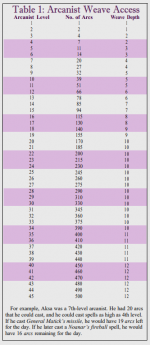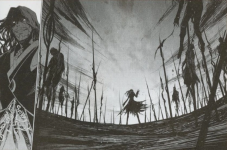An archetype based on
Vlad III of Fate Apocrypha using some abilities taken from the
Dread Impaler PrC.
Alters edict of the order of the guard;
Replaces proficiency with medium and heavy armors and shields, mount, noble steed, skilled diplomat, cavalier’s charge, knight’s renown, measured gait, talented orator, iron steed, risky lunge, noble’s renown, rider’s bond, mighty charge, steed’s parry, powerful steed, general’s awe, supreme charge
Alignment: A Dread Tepest must be any non-Good.
AC Bonus: When unarmored and unencumbered, the Dread Tepest adds his Charisma bonus (if any) to his AC and his CMD. In addition, a Dread Tepest gains a +1 bonus to AC and CMD at 4th level. This bonus increases by 1 for every four legendary cavalier levels thereafter, up to a maximum of +5 at 20th level.
These bonuses to AC apply even against touch attacks or when the Dread Tepest is flat-footed. He loses these bonuses when he is immobilized or helpless, when he wears any armor, when he carries a shield, or when he carries a medium or heavy load.
This replaces the Dread Tepes proficiency with medium and heavy armors and shields.
Order (Ex): A Dread Tepes can only select between the Order of the Guard (but see below), Nobility, No Quarter, Scorpion, or Unity.
If a Dread Tepes select Guard, its edict does not obliges him to fight in the service of those who cannot fight for themselves.
This alters Order and the edict of the Order of the Guard.
Sanguine Sustenance (Ex): At 1st level, a Dread Tepes can sustain himself with the blood of his enemies. If he drink a single pint of blood which belonged to a sapient creature, he count as having consumed enough food and drink for the day. When he rest, if he consumed enough blood to sustain himself for that day, he recover twice the amount of hit point and ability damage from rest.
This replaces noble steed.
Summon Pike (Su): At 1st level, as a standard action, as long the Dread Tepes wield any appropriately sized weapon of the spear weapon group in one hand he can summon an iron pike under his opponent. He select a single grounded square within 10 feet per legendary cavalier level of him, and make an attack roll using his Charisma modifier instead of his Strength against any creature in that square. The pike deal 1d6 + the Dread Tepes's Charisma modifier (if any) in magical piercing damage with a 20/x3 critical modifier. The base damage increases by 1d6 every two legendary cavalier levels thereafter (2d6 + Cha at level 3rd, 3d6 + Cha at level 5th, and so on). If the creature is helpless or dying, this is made as a coup de grace instead of an attack, with the difference that it is a standard action and for the attack of opportunity a sunder combat maneuver can be made to break the pike before it can hit the unfortunate victim.
The Dread Tepes’s pikes are treated as if they had the
ghost touch magic weapon property. A pike has hardness 8 and a number of hit points equal to the Dread Tepes level. Vital Strike and his feat tree can be used with summon pike. Every Dread Tepes has his pike with unique decorations and marks and are often the calling card for that specific Dread Tepes.
A creature slain by Summon Pike is impaled 15 feet above the square. The spike stay in existence permanently and count as difficult terrain. It is made of a weird ferrous structure, which is as hard as steel but quickly break down in valueless chunk if broken down.
At 5th level, the pikes are treated as cold iron and silver for the purpose of overcoming damage reduction.
At 7th level, the Dread Tepes selects one of the following alignment components: chaotic, evil, or lawful. He must select an alignment component that matches a component of his own alignment (a neutral Dread Tepes can chose any alignment component other than Good). His pikes are treated as the alignment component he selects for the purpose of overcoming damage reduction.
At 16th level, his pikes are treated as adamantine weapons for the purpose of overcoming damage reduction and bypassing hardness.
This replaces mount.
The Long Arm of the Executioner (Ex): At 1st level, a Dread Tepes can wield any appropriately sized two-handed weapon of the spear weapon group in one hand. Wielding a two-handed weapon in this way is treated as a one-handed weapon for the purpose of Power Attack and other effects that increase the damage of two-handed weapons. When using any appropriately sized two-handed weapon of the spear weapon group with the reach property, the Dread Tepes may attack adjacent foes with that weapon without penalty.
This replaces cavalier’s charge.
Aura of Dread (Su): At 2nd level, a Dread Tepes radiates a palpably daunting aura that causes all enemies within 10 feet to take a –4 penalty on saving throws against fear effects. Enemies creatures that are normally immune to fear lose that immunity while within 10 feet of a Dread Tepes with this ability. This ability functions only while the Dread Tepes remains conscious, not if he is unconscious or dead. This don’t stack with the antipaladin Aura of Cowardice class feature.
This replaces skilled diplomat.
The Legend of the Vampire (Su): At 3rd level, a Dread Tepes gains the Shifter Aspect class feature of the shifter and he must select the bat aspect. A Dread Tepes use his legendary cavalier level as his shifter level for calculate the benefit of the minor form of the at aspect. He does not gains additional aspects progressing with the level unlike a true shifter.
This replaces knight’s renown.
Intercept with the Spear (Ex): At 4th level, when an opponent makes a weapon attack against the Dread Tepes or an adjacent ally, he can expend a use of an attack of opportunity to attempt to parry that attack with a spear-like weapon. The Dread Tepes makes an attack roll with a weapon of the spear weapon group as if he was making an attack of opportunity; for each size category the attacking creature is larger than the Dread Tepes, the Dread Tepes takes a –2 penalty on this roll. If his result is greater than the attacking creature’s result, the creature’s attack automatically misses. Unusually massive ranged weapons (such as boulders or ballista bolts) and ranged attacks generated by spell effects cannot be deflected. The Dread Tepes must declare the use of this ability after the creature’s attack is announced, but before its attack roll is made.
This replaces measured gait.
Terrible King (Ex): At 5th level, a Dread Tepes gains the skill unlock for Intimidate. If he has select the Order of the Scorpion, he instead gains Killing Flourish as a bonus feat without the need to meet its prerequisites.
Also, if the Dread Tepes is a living creature, he do not age for that day as long as he has drink a pint of blood from a sentient creature within the last 24 hours; for each pint, he become instead younger by a number of days at sunset equal to the number of pints of blood of sentient creatures drinked within the last 24 hours. He instead become one full year younger if he killed at least 100 HD of sentient creatures within the last 24 hours using summon pike, kazikli bey, or a weapon of the spear weapon group (this stack with any pint of blood drinked). He cannot become younger than the base starting age for his race by use of this ability.
If he is slain by violence, he rise as a non-mindless undead (change his type to undead [augmented] with all the beneficts and drawback of the case) so long as he killed at least one sentient creature with a number of HD equal to his character level with summon pike, kazikli bey, or a weapon of the spear weapon group within the last 24 hours.
If he is an undead creature, he rise again in 2d4 days – much like the rejuvenation ability of a ghost – if destroyed, so long as he killed at least one sentient creature with a number of HD equal to his character level with summon pike, kazikli bey, or a weapon of the spear weapon group within the last 24 hours.
This replaces talented orator.
Uncanny Climber (Su): At 6th level, a Dread Tepes can climb with his hands (or upper limbs) free and even walk about on the ceiling as if affected by a
spider climb spell. In addition, he can use the accelerated climb action to cover any distance up to four times his climb speed, with each check allowing him to climb a distance equal to his climb speed. Climbing a distance equal to or less than his climb speed is a move-equivalent action. A Dread Tepes can use uncanny climber for a number of minutes per day equal to his legendary cavalier level. The minutes don’t have to be used consecutively, but must be used in 1-minute increments.
This replaces compact mount.
Vampire Grace (Ex): At 7th level, if a Dread Tepes consumed enough blood to sustain himself for that day, he gains a +1 dodge bonus to AC and Reflex saves until the start of the next day. At 11th level and every 4 levels afterwards, this dodge bonus increases by 1.
This replaces iron steed.
Children of the Night (Su): At 7th level, a Dread Tepes can command the lesser creatures and undead of the world. Three times a day, as a standard action, a Dread Tepes can summon creature of the animal, vermin, or undead type (including swarm of this creatures). Each creature summoned must have an Intelligence score of 2 or lower. The Dread Tepes can summon any combination of creatures so long as their total Hit Dice is less than the Dread Tepes’s. Summoned creatures arrive in 2d6 rounds and serve the Dread Tepes for up to 1 hour. Only once instance of this ability can be active at a time.
This replaces risky lunge.
Wild Shape (Su): At 8th level, a Dread Tepes gains the ability to turn himself into the major form of his bat aspects. This ability functions as
beast shape II, except as noted here. Using wild shape to change to a major form or back is a standard action that doesn’t provoke attacks of opportunity. The bat major form details the abilities the Dread Tepes gains with that major form and at what level; he gains these instead of the form abilities from
beast shape II, but he still gains
beast shape II abilities that are size dependent.
A Dread Tepes loses his ability to speak while in animal form because he is limited to the sounds that a normal, untrained animal of that form can make, but he can communicate with other animals of the same general grouping as his form. He can also communicate in nonverbal ways with allies.
A Dread Tepes can use wild shape for a number of hours each day equal to his legendary cavalier level + his Charisma modifier. It need not be consecutive but must be spent in 1 hour increments. For abilities that function based on ‘uses of wild shape,’ each hour of wild shape counts as a use.
A Dread Tepes can take feats and other abilities that require wild shape but not abilities that allow to transform in other creatures; for the purpose of qualifying for prerequisites, his effective druid level is equal to his legendary cavalier level.
This replaces noble’s renown.
Blood Drain (Ex): At 9th level, a Dread Tepes grow canines similar to those of a vampire. If the Dread Tepes establishes or maintains a pin, he drains blood, dealing 1d2 points of Constitution damage. The Dread Tepes heals 5 hit points or gains 5 temporary hit points for 1 hour (up to a maximum number of temporary hit points equal to his full normal hit points) each round he drains blood. Draining blood of a sentient creature in this way count as consuming a pint of blood for sanguine sustenance and vampire grace.
At 17th level, the ability damage increase to 1d4+1.
This replaces rider’s bond.
Lord of the Land (Ex): At 11th level, a Dread Tepes becomes well known in a specific community in which he gains the benefits of renown. He gains the great renown and renown vigilante social talents, treating his legendary cavalier level as his vigilante level for this ability. For the purposes of this class feature, the Dread Tepes does not have a vigilante identity and is always considered to be in his social identity.
This replaces mighty charge.
All-Seeing (Sp): At 12th level, nothing happens in the Dread Tepes’s realm without he becoming aware. He can use
clairaudience/clairvoyance,
speak with animals,
speak with plants, and
stone tell as spell-like abilities each three times per day with caster level equal to his legendary cavalier level. The Dread Tepes can only use and benefit from this spell-like abilities while inside his community of renown. Unlike the normal
clairaudience/clairvoyance, the spell’s range change to cover the entire community of renown, but cannot be used to see outside of it.
This replaces steed’s parry.
Great Spear (Ex): At 13th level, a Dread Tepes treats any weapon of the spear weapon group as one size category larger for how much damage it deals. This ability does not stack with other virtual size increases, such as the
impact weapon enhancement.
This replaces powerful steed.
Vampire’s Awe (Su): At 18th level, a Dread Tepes can spend 4 rounds of his commander’s aura for try to crush an opponent’s will as a standard action. The opponent must make a Will save DC 10 + ½ the legendary cavalier’s level + his Charisma modifier or fall instantly under his influence as though by a
dominate monster spell (caster level equals the Dread Tepes’s legendary cavalier level). Once a creature succeed his save, he become immune to the vampire’s awe of the same Dread Tepes for 24 hours. The ability has a range of 30 feet and is a compulsion, mind-affecting effect.
This replaces general’s awe.
Legendary Presence (Su): At 19th level, a Dread Tepes gains a bonus equal to his Charisma bonus (if any) on all saving throws.
This replaces supreme charge.
Kazikli Bey, The Lord of Execution (Su): At 20th level, a Dread Tepes has mastered the art of massacre with the spear. The Dread Tepes can chose from three option:
effect an area around himself of 10 ft. per legendary cavalier level wide, 30 ft. per legendary cavalier level in height.
effect a line in front of him of 20 ft. per legendary cavalier level long, 5 ft. per legendary cavalier level wide, 5 ft. per legendary cavalier level in height.
effect a single enemy within 10 ft. per legendary cavalier level.
In the first two options a tempest of spears hit the area and all creatures within takes 2d6 magical piercing damage per legendary cavalier level with a Reflex save DC 10 + ½ the legendary cavalier’s level + his Charisma modifier for half damage. The Dread Tepes can choose to exclude a number of creature in the area equal to his Charisma modifier. In the third option the storm of spears target a single enemy which takes 3d6 magical piercing damage per legendary cavalier level with a Reflex save DC 10 + ½ the legendary cavalier’s level + his Charisma modifier for half damage. Targets that have total cover from the point of origin of the effect (from the sky for the first option, from the Dread Tepes himself for the second and third) are immune to Kazikli Bey. Even if it is a supernatural, once the weapons are materialized they are real, even if only for a brief moment: they ignore the effect of dead magic zones or antimagic fields. This ability can be used once every hour, with a maximum number of time per day equal to the Dread Tepes Charisma modifier (every time he can chose any option, not only the one that he used the last time). The spears of Kazikli Bey count as adamantine, cold iron, iron, silver,
ghost touch weapons plus the alignment select at 7th level with summon pike for the purpose of overcoming damage reduction, bypassing hardness, and affecting incorporeal creatures.



